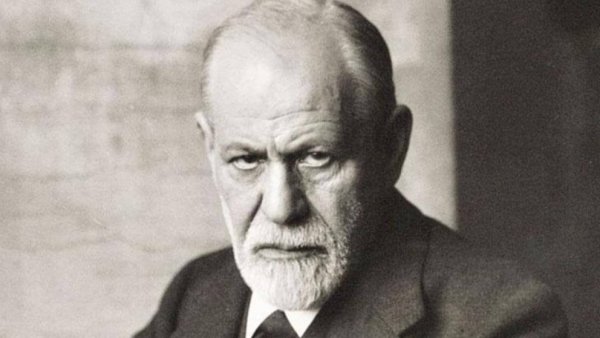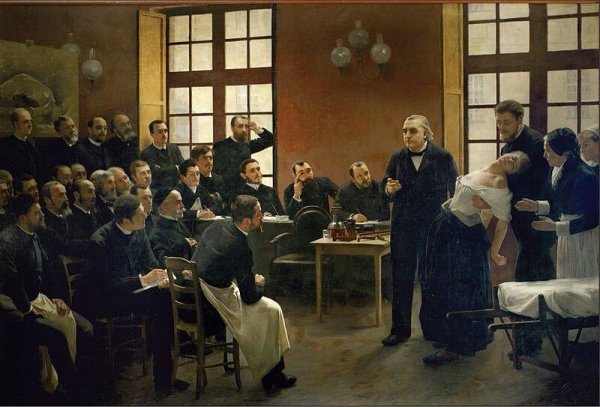Jean-Martin Charcot, The Forefather of Psychoanalysis

Many great thinkers have passed through this world, leaving important contributions. Jean-Martin Charcot was one of them. His ideas were just as important for understanding how certain procedures worked, as well as why they didn’t work.
Charcot was born to a humble family in Paris, France. From a young age, he showed a passion for learning. Since he was the sibling who showed the most promise in elementary school, his father decided to let him continue studying.
Charcot became a neurologist and an anatomy professor. He stood out due to his uncommonly masterful abilities for analysis and synthesis. Because of this, he made great contributions to, among other things, what would later become the field of psychoanalysis.
“If the clinician, as an observer, wants to see things as they truly are, they must make a clean slate of their mind without any preconceived notions.”
-Jean-Martin Charcot-
Jean-Martin Charcot and Sigmund Freud
Charcot studied medicine at the University of Paris and became interested in neurology. He worked for more than 30 years at the Pitié-Salpêtrière University Hospital. There, he dedicated much of his time to research. Thanks to those contributions, he’s also considered to be one of the fathers of modern neurology.
At Salpêtrierè, he had the opportunity to observe and study diverse patients and to explore their actual minds during autopsies. This helped him find correlations between their symptoms and the physiological anomalies they presented.
During his stay at Salpêtrierè, he met Sigmund Freud. During this time, Salpêtrierè treated a lot of psychiatric patients. Charcot studied them and Freud learned from him.
This is how Charcot influenced Freud, who was impressed by the systematic way in which he worked. Charcot’s influence can also be seen in Freud’s study of hysteria. This, of course, wouldn’t be the only idea that stuck with Freud. At the beginning, for example, he also learned about techniques for diagnosing patients.

Jean-Martin Charcot and his research on hysteria and hypnosis
Most of the patients at Salpêtrierè showed symptoms of hysteria. Charcot wanted to lend another viewpoint of this condition. In fact, he was the first one to say that it didn’t have anything to do with problems with the uterus but that it was a neurological problem instead.
He also suggested that the foundations of hysteria might be connected to experiences from patients’ pasts. From this basis, he formed a new hypothesis regarding symptoms of paralysis, hypersensitivity, pain relief, unexplained pain, etc.
This went against many of the popular beliefs at the time. He vindicated “male” hysteria, especially in professions such as railroad engineering and the military. It didn’t take him long to realize that the symptoms of hysteria were similar to hypnosis: they both had similar effects, including pain relief and paralysis.
Toward the end of his life, he recognized that his theory of suggestions through hypnosis was wrong. Even so, his contributions were essential to neurology and psychoanalysis. In fact, it was he who made neurology a defined specialty within medicine and made Salpêtrierè one of the most prestigious institutions in that field.
Charcot’s contributions to psychoanalysis
Charcot made great contributions to neurology. For example, he discovered amyotrophic lateral sclerosis. But this was not his only legacy as a precursor for psychoanalysis:
- He thought about hysteria in a new way. Thanks to this new vision of the condition, Freud was able to continue studying it, making it a pillar of psychoanalytical development.
- He worked with the hypothesis that the origin of diseases could be related to past experiences. Trauma was a fundamental part of Freud’s work in psychoanalysis, and it was Charcot who showed that it had an effect on some nervous conditions.
- He got closer to understanding mental diseases. His research was key for the development of psychopathology and, as a result, to different branches that were dedicated to the study of these conditions, such as psychoanalysis.
- His teachings influenced others. Freud learned from his teacher Charcot about ways of researching, analyzing, and developing a diagnosis. These were important for consolidating the different aspects of psychoanalysis, though Freud later gave it more form.

Freud learned a lot from Charcot, and Charcot transformed his legacy, betting on a new perspective of how society could understand mental diseases. He even created his own nosological system.
Charcot was an important forefather of psychoanalysis because he inspired ideas that Freud later developed and gave more refined form to. Though history doesn’t consider him the father of psychoanalysis, he was, nevertheless, a great influence on its creation.
Many great thinkers have passed through this world, leaving important contributions. Jean-Martin Charcot was one of them. His ideas were just as important for understanding how certain procedures worked, as well as why they didn’t work.
Charcot was born to a humble family in Paris, France. From a young age, he showed a passion for learning. Since he was the sibling who showed the most promise in elementary school, his father decided to let him continue studying.
Charcot became a neurologist and an anatomy professor. He stood out due to his uncommonly masterful abilities for analysis and synthesis. Because of this, he made great contributions to, among other things, what would later become the field of psychoanalysis.
“If the clinician, as an observer, wants to see things as they truly are, they must make a clean slate of their mind without any preconceived notions.”
-Jean-Martin Charcot-
Jean-Martin Charcot and Sigmund Freud
Charcot studied medicine at the University of Paris and became interested in neurology. He worked for more than 30 years at the Pitié-Salpêtrière University Hospital. There, he dedicated much of his time to research. Thanks to those contributions, he’s also considered to be one of the fathers of modern neurology.
At Salpêtrierè, he had the opportunity to observe and study diverse patients and to explore their actual minds during autopsies. This helped him find correlations between their symptoms and the physiological anomalies they presented.
During his stay at Salpêtrierè, he met Sigmund Freud. During this time, Salpêtrierè treated a lot of psychiatric patients. Charcot studied them and Freud learned from him.
This is how Charcot influenced Freud, who was impressed by the systematic way in which he worked. Charcot’s influence can also be seen in Freud’s study of hysteria. This, of course, wouldn’t be the only idea that stuck with Freud. At the beginning, for example, he also learned about techniques for diagnosing patients.

Jean-Martin Charcot and his research on hysteria and hypnosis
Most of the patients at Salpêtrierè showed symptoms of hysteria. Charcot wanted to lend another viewpoint of this condition. In fact, he was the first one to say that it didn’t have anything to do with problems with the uterus but that it was a neurological problem instead.
He also suggested that the foundations of hysteria might be connected to experiences from patients’ pasts. From this basis, he formed a new hypothesis regarding symptoms of paralysis, hypersensitivity, pain relief, unexplained pain, etc.
This went against many of the popular beliefs at the time. He vindicated “male” hysteria, especially in professions such as railroad engineering and the military. It didn’t take him long to realize that the symptoms of hysteria were similar to hypnosis: they both had similar effects, including pain relief and paralysis.
Toward the end of his life, he recognized that his theory of suggestions through hypnosis was wrong. Even so, his contributions were essential to neurology and psychoanalysis. In fact, it was he who made neurology a defined specialty within medicine and made Salpêtrierè one of the most prestigious institutions in that field.
Charcot’s contributions to psychoanalysis
Charcot made great contributions to neurology. For example, he discovered amyotrophic lateral sclerosis. But this was not his only legacy as a precursor for psychoanalysis:
- He thought about hysteria in a new way. Thanks to this new vision of the condition, Freud was able to continue studying it, making it a pillar of psychoanalytical development.
- He worked with the hypothesis that the origin of diseases could be related to past experiences. Trauma was a fundamental part of Freud’s work in psychoanalysis, and it was Charcot who showed that it had an effect on some nervous conditions.
- He got closer to understanding mental diseases. His research was key for the development of psychopathology and, as a result, to different branches that were dedicated to the study of these conditions, such as psychoanalysis.
- His teachings influenced others. Freud learned from his teacher Charcot about ways of researching, analyzing, and developing a diagnosis. These were important for consolidating the different aspects of psychoanalysis, though Freud later gave it more form.

Freud learned a lot from Charcot, and Charcot transformed his legacy, betting on a new perspective of how society could understand mental diseases. He even created his own nosological system.
Charcot was an important forefather of psychoanalysis because he inspired ideas that Freud later developed and gave more refined form to. Though history doesn’t consider him the father of psychoanalysis, he was, nevertheless, a great influence on its creation.
All cited sources were thoroughly reviewed by our team to ensure their quality, reliability, currency, and validity. The bibliography of this article was considered reliable and of academic or scientific accuracy.
- Guerrero, A. L. (2009). Charcot: historia de un descubrimiento. Revista española de Esclerosis Múltiple, 11, pp. 11-17.
- Micale, M.S. (1985). The Salpêtrière in the age of Charcot; an institutional perspective on medical history in the late nineteenth century. Journal of contemporany history, 20 (4), pp. 703-731.
- Lepoutre, T., & Villa, F. (2015). Freud con Charcot: El descubrimiento de Freud y la cuestión del diagnóstico. The international Journal of Psychoanalysis (en español), 1 (2), 362-390.
- Tan S.Y. S. Y., & Shigaki, D. (2007). “Jean-Martin Charcot (1825-1893): pathologist who shaped modern neurology”. Singapore medical journal, 2007. vol. 48, no 5, pp. 383-384.
This text is provided for informational purposes only and does not replace consultation with a professional. If in doubt, consult your specialist.







